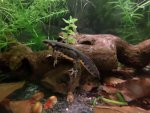- Joined
- Oct 14, 2004
- Messages
- 3,259
- Reaction score
- 59
- Points
- 48
- Location
- Bristol
- Country
- United Kingdom
That captive breeding is best!
Cynops pyrrhogaster bred by Jesper Danielsson


Pleurodeles waltl bred by myself

M. a. apuanus bred by Alan Cann

Triturus marmoratus bred by myself.

I can feel a diet coming on....

Neurergus strauchii bred by Jennifer Macke.


Calotriton asper bred by Günter Schultschik.


Neurergus kaiseri bred by Alan Cann.


Cynops pyrrhogaster bred by Jesper Danielsson


Pleurodeles waltl bred by myself

M. a. apuanus bred by Alan Cann

Triturus marmoratus bred by myself.

I can feel a diet coming on....

Neurergus strauchii bred by Jennifer Macke.


Calotriton asper bred by Günter Schultschik.


Neurergus kaiseri bred by Alan Cann.







